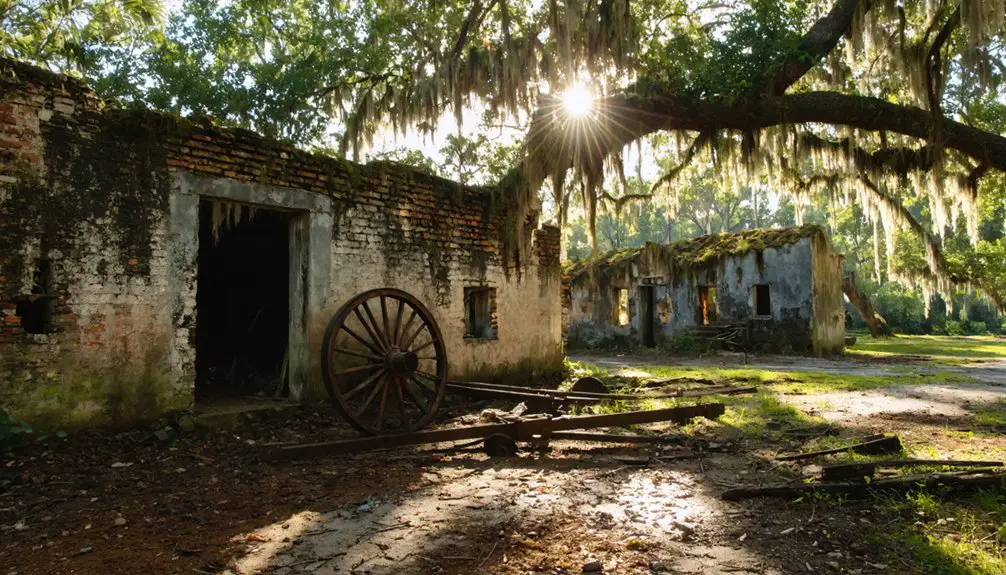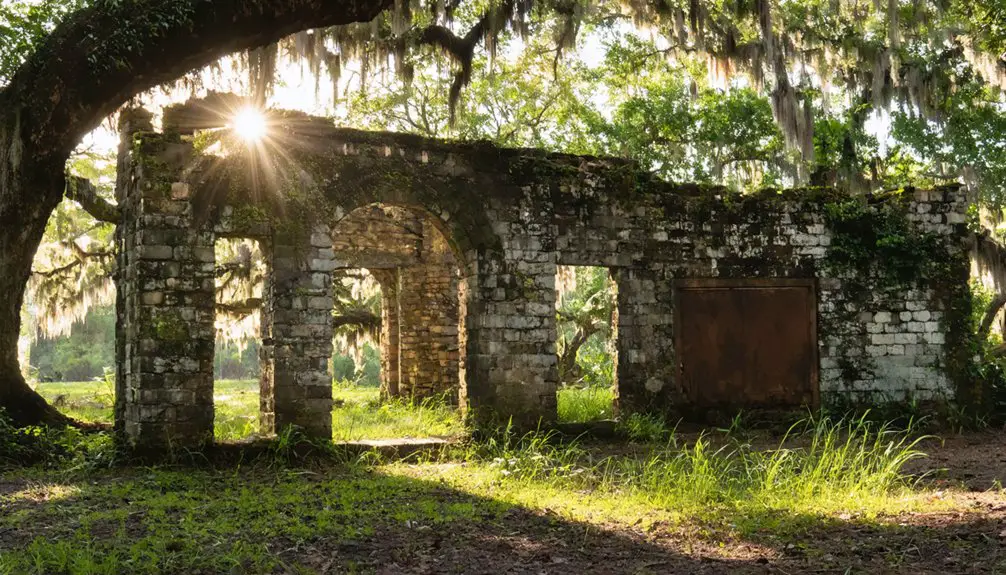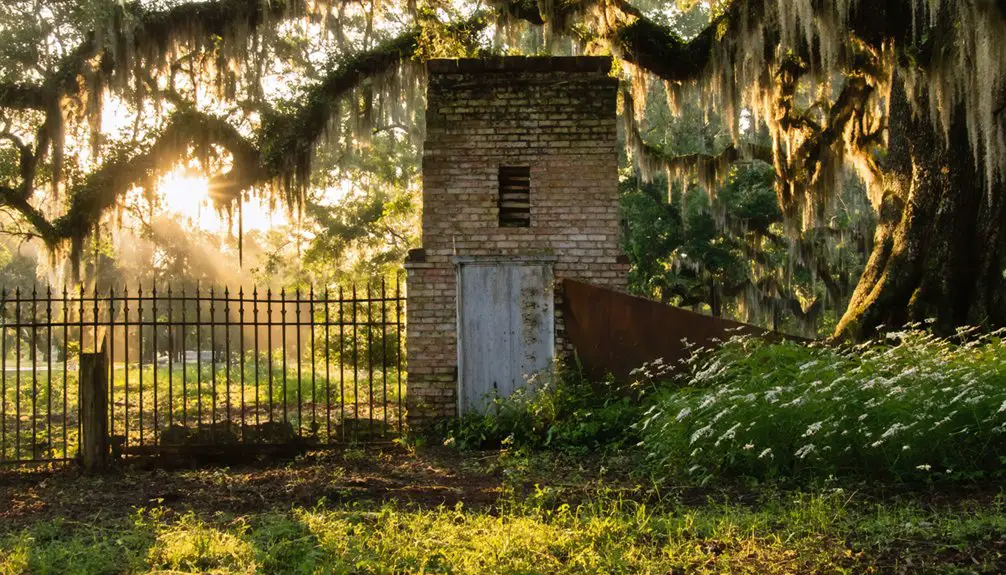You’ll find Shiloh’s ghost town remnants at 28.79055°N, 80.80450°W on Merritt Island, Florida, where a thriving agricultural community once prospered from the 1840s through 1962. The settlement began with Timucua and Ais tribes before European pioneers established citrus groves, cotton fields, and turpentine operations. NASA’s acquisition of 84,000 acres for the space program transformed this living community into protected land within Merritt Island National Wildlife Refuge, where traces of its rich past still linger.
Key Takeaways
- Shiloh was an 1840s farming settlement in Florida that became a ghost town after NASA’s acquisition of Merritt Island in 1962.
- The community thrived on citrus, cotton, and turpentine production before its residents were displaced for NASA’s buffer zone requirements.
- Located at 28.79055°N, 80.80450°W in Brevard County, Shiloh’s remains now lie within Merritt Island National Wildlife Refuge.
- NASA purchased 84,000 acres, including Shiloh, transforming the agricultural community into protected land for space operations.
- Historical artifacts, shell middens, and burial mounds from original Timucua and Ais tribes remain as evidence of early settlement.
Native American Origins and Early Settlements
Before European contact, the area around Shiloh, Florida served as home to two prominent Native American groups: the Timucua north of Haulover and the Ais to the south. The Timucua cultivated corn, beans, and squash, while the Ais thrived on fishing and hunting along the coast.
These native tribes left behind shell middens and burial mounds that reveal centuries of continuous settlement. Like the inhabitants at seven platform mounds in Tennessee’s Shiloh site, these Florida tribes constructed elaborate earthworks.
Shell middens and burial mounds stand as silent witnesses to generations of native peoples who made this land their enduring home.
Archaeological evidence shows that ancient rituals and complex social behaviors defined life in Shiloh as far back as 2,000 years ago.
You’ll find remarkable village remains with multiple burial mounds dating to 800-900 AD. The settlement patterns demonstrate how indigenous peoples strategically chose locations offering reliable food sources, fresh water, and elevated dry ground – ensuring their communities could flourish in this rich Florida landscape.
In the 1840s, the Armed Occupation Act encouraged new settlement in the region by opening 200,000 acres of land for development.
European Pioneer Settlement and Growth
During the 1840s, Shiloh’s landscape transformed dramatically as settlers from Georgia and the Carolinas streamed into the area under the Armed Occupation Act of 1842. Settler motivations centered on the promise of 160 free acres if they’d cultivate the land and live there for five years.
Emanuel Geiger from South Carolina pioneered this agricultural frontier, clearing forestland for farming. Much like the precious metals that initially drew English settlers to Jamestown, the promise of prosperity attracted pioneers to this new territory.
The community dynamics revolved around diverse crop cultivation, including citrus, cotton, and sugarcane, with settlers also raising livestock. You’d have witnessed Shiloh’s agricultural success peak when Douglas Dummitt’s citrus groves became Florida’s largest by 1867.
However, the settlement faced significant challenges: the Civil War drained manpower, 1890s freezes devastated crops, and early 1900s boll weevils forced many farmers to seek alternative livelihoods in industries like turpentine extraction. The area’s Timucua and Seminole tribes had inhabited the region long before European settlers arrived.
Agricultural Golden Age and Economic Development
You’ll find Shiloh’s agricultural golden age centered around its thriving citrus operations, which by the 1880s supported a bustling fruit packing company and essential commercial infrastructure.
The town’s strategic position and growing labor force helped establish it as a crucial trade hub, complete with a store, church, and post office serving the agricultural community. Like other early settlements, residents adapted to cultivate pineapples for export, diversifying their agricultural output. Transportation challenges often led to spoiled produce, making successful shipments highly profitable for farmers.
Shiloh’s economic expansion was further strengthened by the arrival of Flagler’s railroad, which connected its citrus producers to broader markets while facilitating the movement of workers and goods throughout South Florida.
Citrus and Cotton Dominance
Throughout Florida’s territorial period after 1821, cotton emerged as the region’s dominant cash crop, particularly in the fertile soils of North Florida’s “Middle Florida” region surrounding Tallahassee.
You’d have seen extensive plantations across Leon, Gadsden, and Jackson counties exporting over 50,000 bales annually through ports like Apalachicola by 1840. Enslaved African Americans constituted nearly half of Florida’s population by 1860, providing the essential labor force for cotton production.
As cotton decline set in during the 1890s due to pest infestations, citrus dominance took hold, especially in areas like Shiloh where the soil supported diverse cultivation.
Here’s what made citrus successful:
- Well-drained Hillsborough County soils proved ideal
- Cover crops improved fertility before synthetic fertilizers
- Diverse cultivars extended fruiting seasons
- Modern packinghouses increased processing efficiency
- University research advanced cultivation methods
These agricultural shifts helped stabilize local economies as cotton’s profitability waned.
Labor and Trade Growth
The rise of agricultural commerce in Shiloh brought significant labor and trade developments by the 1880s. Labor dynamics evolved around citrus cultivation, with workers clearing marshes, digging canals, and managing invasive species.
You’d find both local residents and itinerant laborers handling tasks from fruit packing to crop maintenance.
Trade networks expanded dramatically when Henry Flagler’s railroad reached the area, connecting Shiloh’s agricultural output to broader markets. The Shiloh Fruit Packing Company became a crucial hub, while improved infrastructure reduced delivery times for perishable goods.
This agricultural golden age transformed the region’s economy, with Hillsborough County becoming a leading producer of strawberries and citrus by 1910. The boom attracted more settlers and workers, creating a thriving commercial ecosystem that supported related industries and local businesses.
The Rise of the Turpentine Industry
During Shiloh’s changeover from agriculture in the late 1800s, you’d have witnessed workers carving deep “box” cuts into local pine trees, creating the distinctive “cat face” scars that marked the beginning of turpentine extraction.
You would’ve seen laborers, primarily African Americans, collecting sticky pine resin in hollowed-out cavities before hauling heavy barrels to the local distillery. Workers were often paid in company store scrip, forcing them to purchase goods at inflated prices from camp-owned facilities. The harsh process of extracting turpentine killed the pine trees, causing operations to continuously move southward in search of fresh timber.
These new turpentine operations transformed Shiloh’s economy, as farming families shifted toward this lucrative industry that offered steady employment through company-owned camps and stores.
Pine Harvesting Methods
As Florida’s turpentine industry flourished in the late 1800s, pine harvesting methods relied heavily on a destructive technique called “boxing,” where workers cut deep hollows at the base of longleaf pines to collect valuable sap.
This traditional pine tapping process involved laborers using specialized tools to chip the trees weekly, stimulating sap flow during the eight-month harvesting season. Dr. Charles Herty revolutionized the industry by developing the more sustainable cap and gully system.
The grueling work of turpentine production included:
- Cutting “cat face” scars using axes and adzes
- Weekly streaking of trees with wood chippers
- Dipping viscous resin from boxes into buckets
- Transferring collected gum to barrels for transport
- Maintaining the harvest for 34 weeks annually
This labor-intensive method typically killed trees within 8-10 years, forcing producers to constantly seek new pine stands as they depleted existing forests.
Economic Community Impact
While destructive pine harvesting methods devastated Florida’s forests, turpentine camps flourished economically throughout North Central Florida from the late 1800s to 1920s.
In Shiloh, the turpentine economy offered essential employment after agricultural setbacks, though workers faced severe labor exploitation. You’d find workers trapped in a cycle of dependency, paid in company scrip only redeemable at camp stores.
The industry’s success helped sustain small communities during tough times when freezes and pests wreaked havoc on farming. Naval industries relied heavily on turpentine resin for sealing ships and preserving ropes, creating steady demand.
However, you couldn’t escape the dark reality of forced peonage and debt slavery that underpinned the industry’s profitability, with workers confined to camp life in modest shanties covered by kudzu vines.
Daily Life in Historic Shiloh

Life in historic Shiloh revolved around the rhythms of agriculture, where families cultivated citrus groves, cotton fields, and vegetable gardens until the Civil War disrupted their established routines.
You’d find daily routines centered around farm work, with community gatherings providing essential social connections. Living conditions were modest, with families occupying self-built cabins using local materials.
When the turpentine industry emerged in the early 1900s, it reshaped work patterns across the settlement.
Key aspects of daily life included:
- Maintaining small tenant cabins along rural back roads
- Participating in shared agricultural activities with neighbors
- Adapting to life without modern utilities
- Supporting each other during economic hardships
- Preserving cultural traditions through storytelling and cemetery visits
Geographic Location and Natural Surroundings
Historic Shiloh’s physical setting held unique geographic features that shaped its development and eventual decline. You’ll find this ghost town at 28.79055°N, 80.80450°W, standing just 13 feet above sea level in Florida’s northernmost reaches of Brevard County.
The site’s historical significance stems from its strategic position on Merritt Island, bordered by Old Haulover Canal and the vast Indian River Lagoon system.
Today, you’re surrounded by remarkable ecological diversity when visiting Shiloh’s former location. The area’s protected status within Merritt Island National Wildlife Refuge has preserved its natural character, featuring coastal wetlands, maritime forests, and pristine dark skies.
You’re in the heart of a barrier island ecosystem, where sandy soils meet brackish waters, and migratory birds share space with native wildlife in this untamed landscape.
Archaeological Discoveries and Cultural Heritage

Recent archaeological investigations have revealed that Shiloh, Florida’s ghost town holds a deeper historical narrative than previously known.
While distinct from its biblical namesake, the site demonstrates notable archaeological significance through extensive excavation efforts that have uncovered cultural markers from early American settlement patterns.
You’ll find evidence of the area’s rich cultural heritage through:
- Preserved architectural foundations revealing settlement layout
- Pottery sherds indicating domestic life patterns
- Artifact assemblages showing trade connections
- Building remains demonstrating construction techniques
- Cultural material suggesting daily life activities
These discoveries contribute to our understanding of Florida’s frontier settlements and the importance of cultural preservation.
The archaeological record here provides valuable insights into the social and economic dynamics of early Florida communities, making Shiloh an important site for studying American settlement history.
The Impact of NASA’s Expansion
You’ll find NASA’s land acquisition of Shiloh traced back to 1962, when the space agency began purchasing 84,000 acres on Merritt Island that extended into southern Volusia County.
The federal expansion forced the complete displacement of Shiloh’s residents as NASA established critical buffer zones and operational areas for its lunar missions.
The transformation of Shiloh from a living community to a ghost town exemplified a broader pattern along Florida’s Space Coast, where several small towns disappeared to accommodate NASA’s growing operational footprint in the 1960s.
Space Program Land Acquisition
During the early 1960s, NASA’s ambitious expansion transformed Florida’s east coast through massive land acquisitions that would ultimately displace the town of Shiloh and several neighboring communities.
You’ll find that NASA’s purchase encompassed roughly 131 square miles of pristine coastal territory, including:
- Undeveloped swampland
- Productive citrus groves
- Natural coastal beaches
- Historic archaeological sites
- Small residential communities
This sweeping acquisition set the stage for modern spaceport development, though environmental regulations would later shape the land’s destiny.
By 1972, much of the non-operational area became the Merritt Island National Wildlife Refuge, creating a unique partnership between space exploration and conservation.
Today, you’ll see the lasting impact of these decisions as NASA continues to balance commercial space interests with environmental preservation around the former Shiloh settlement.
Community Displacement Timeline
As NASA’s expansion plans took shape in the early 1960s, Shiloh’s transformation from a modest agricultural community to an abandoned settlement accelerated rapidly.
You’ll find that by 1950, the town’s population had already begun declining, with nearby communities dropping below 150 residents.
The final blow to community resilience came between the late 1950s and 1960s when post offices closed and essential services vanished.
Remnants and Structural Remains Today

Shiloh’s remnants tell a sparse tale of what once was, with only scattered fragments of infrastructure still visible today.
You’ll find ghostly echoes of the past along Taylor Road, which now serves as a boat ramp access point. The forgotten footprints of foundations near Shiloh Cemetery hint at former church buildings, while nature steadily reclaims the abandoned streets and lots.
What remains of Shiloh today:
- Shiloh Cemetery within Withlacoochee State Forest
- Taylor Road and its functional boat ramp
- Foundation bricks around the cemetery area
- Several abandoned streets and parking lots
- Historic road patterns visible in 1956 maps
The landscape has transformed dramatically, with no standing structures surviving the Kennedy Space Center expansion.
Environmental restrictions have temporarily preserved some remnants, though vegetation continues to envelope what’s left of this once-thriving community.
Legacy of a Lost Community
Though initially established as Geiger in the 1840s, the legacy of Shiloh transcends its humble agricultural origins to embody a remarkable transformation in Florida’s history.
From its roots as a farming settlement where pioneers battled harsh conditions to its evolution through the turpentine boom, you’ll find a story of resilience etched into Marion and Brevard Counties’ past.
Through sweat and determination, settlers transformed untamed wilderness into thriving farmland, leaving an indelible mark on Florida’s agricultural heritage.
Today, while the community memories live on through descendants of original settlers, Shiloh’s cultural significance has taken an unexpected turn.
The land that once supported cotton and citrus now serves science and conservation as part of the Kennedy Space Center complex.
You’ll discover its darkest legacy in its night sky – where amateur astronomers gather at a pristine observation site, connecting Shiloh’s past to humanity’s reach for the stars.
Frequently Asked Questions
Were There Any Notable Ghost Stories or Supernatural Legends in Shiloh?
Despite 100+ years of history, you won’t find documented haunted locations or ghostly encounters here. The area’s abandonment created an eerie atmosphere, but no supernatural legends were officially recorded or widely shared.
What Happened to the Residents Who Were Forced to Relocate?
You’ll find former Shiloh residents scattered across nearby Florida towns, having lost their farms and community ties. They’ve preserved their relocation impact through oral histories while adapting to new lives elsewhere.
Did Any Famous People Ever Live in or Visit Shiloh?
You won’t find any famous visitors or historically significant celebrities in Shiloh’s records. The community consisted mainly of farming families who worked the land before NASA’s acquisition of the area.
What Was the Highest Recorded Population of Shiloh During Its Peak?
You won’t find exact population statistics for Shiloh’s peak years, as historical records don’t provide specific numbers. Though it was likely a small rural settlement with fewer than 100 residents.
Were There Any Major Crimes or Significant Law Enforcement Incidents?
Ever wonder about law enforcement in remote farming towns? You won’t find any documented major crimes or significant law enforcement incidents in historical records. No crime statistics were preserved from this rural community’s era.
References
- https://theforgottensouth.com/florida-turpentine-cabin-history/
- https://en.wikipedia.org/wiki/Shiloh
- http://wikimapia.org/4281916/Former-site-of-Shiloh-Florida
- http://www.gribblenation.org/2018/02/ghost-town-tuesday-ghost-towns-of.html
- https://nbbd.com/godo/minwr/ShilohAreaFactSheet.pdf
- https://www.nps.gov/shil/moundshistory.htm
- https://www.wuft.org/untold-florida/2021-05-18/untold-florida-the-history-of-the-tenant-houses-in-shiloh
- https://en.wikipedia.org/wiki/Shiloh_Indian_Mounds_Site
- https://dos.fl.gov/florida-facts/florida-history/16th-century-settlements/
- https://npshistory.com/publications/shil/history.pdf



